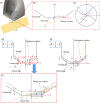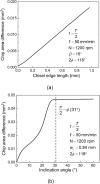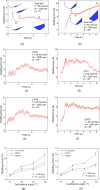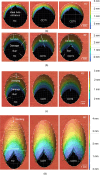Design and performance analysis of low damage anti-skid crescent drills for bone drilling
- PMID: 39153973
- PMCID: PMC11330616
- DOI: 10.1186/s13018-024-04983-7
Design and performance analysis of low damage anti-skid crescent drills for bone drilling
Abstract
Background: With orthopedic surgery increasing year on year, the main challenges in bone drilling are thermal damage, mechanical damage, and drill skid. The need for new orthopedic drills that improve the quality of surgery is becoming more and more urgent.
Methods: Here, we report the skidding mechanism of drills at a wide range of inclination angle and propose two crescent drills (CDTI and CDTII). The anti-skid performance and drilling damage of the crescent drills were analyzed for the first time. Inclined bone drilling experiments were carried out with crescent drills and twist drills and real-time drilling forces and temperatures were collected.
Results: The crescent drills are significantly better than the twist drill in terms of anti-skid, reducing skidding forces, thrust forces and temperature. The highest temperature is generated close to the upper surface of the workpiece rather than at the hole exit. Finally, the longer crescent edge with a small and negative polar angle increases the rake angle of the cutting edge and reduces thrust forces but increases skidding force and temperature. This study can promote the development of high-quality orthopedic surgery and the development of new bone drilling tools.
Conclusion: The crescent drills did not skid and caused little drilling damage. In comparison, the CDTI performs better in reducing the skidding force, while the CDTII performs better in reducing the thrust force.
Keywords: Bone drilling; Drilling Force; Skid resistance; Temperature.
© 2024. The Author(s).
Conflict of interest statement
The authors declare no competing interests.
Figures








Similar articles
-
Novel crescent drill design and mechanistic force modeling for thrust force reduction in bone drilling.Med Eng Phys. 2022 May;103:103795. doi: 10.1016/j.medengphy.2022.103795. Epub 2022 Apr 6. Med Eng Phys. 2022. PMID: 35500995
-
Surgical drilling: design and performance of an improved drill.J Biomech Eng. 1982 Aug;104(3):245-52. doi: 10.1115/1.3138356. J Biomech Eng. 1982. PMID: 7120951
-
Comparison of cortical bone drilling induced heat production among common drilling tools.J Orthop Trauma. 2015 May;29(5):e188-93. doi: 10.1097/BOT.0000000000000240. J Orthop Trauma. 2015. PMID: 25233167
-
Parameters affecting mechanical and thermal responses in bone drilling: A review.J Biomech. 2018 Apr 11;71:4-21. doi: 10.1016/j.jbiomech.2018.02.025. Epub 2018 Mar 1. J Biomech. 2018. PMID: 29559242 Review.
-
Surgical drilling of curved holes in bone - a patent review.Expert Rev Med Devices. 2019 Apr;16(4):287-298. doi: 10.1080/17434440.2019.1596794. Epub 2019 Apr 2. Expert Rev Med Devices. 2019. PMID: 30889370 Review.
References
-
- Robles-Linares JA, Axinte D, Liao Z, Gameros A. Machining-induced thermal damage in cortical bone: necrosis and micro-mechanical integrity. Mater Des. 2021;197:109215. 10.1016/j.matdes.2020.109215.10.1016/j.matdes.2020.109215 - DOI
MeSH terms
Grants and funding
LinkOut - more resources
Full Text Sources

